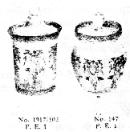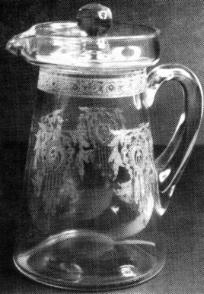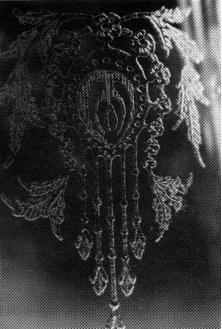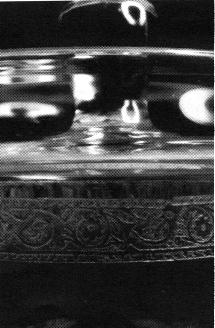The First Cambridge Plate Etch Design
by Joseph A.A. Bourque Sr.
Issue No. 295 - November 1997
Dear Reader,
Early Cambridge Glass items are quite interesting, especially if they are plate etched. Most of these items are of clear glass.
The early Cambridge glass items from 1902 to about 1925 are scarce,
and some fall into the rare category. There are two particular items
within this grouping that I have been seeking for about 25 years. Both
 can be found in Welker 1 - 97, lower left corner. Both are marmalades
Nos 1917/102 and 147
can be found in Welker 1 - 97, lower left corner. Both are marmalades
Nos 1917/102 and 147
What particularly gains my interest is not only because they are early marmalades, but because both bear the Cambridge, Ohio, Glass Company's first plate etching number: "P.E. 1." (Shown at right)
A few months ago, while in a New England co-op shop, I found a small
jug-type, handled syrup in clear glass It had a cover with ball finial,
which rested within the collartype rim. When I lifted it out of its
gloomy shelf corner and rubbed some of the dust off, I discovered it
was plate etched. I recalled having seen the design or one like it
 before, but could not place it. Though Cambridge had made a similar
blank, I was uncertain whether or not the acid etching was made by
them. Under these circumstances, I usually pass up the item, which is
what I did. When I finished searching through the rest of the booths,
and not having found a single Cambridge item all day, I returned to the
collared-rim syrup. Without hesitation, I scooped it up, took it to the
register, and purchased it.
before, but could not place it. Though Cambridge had made a similar
blank, I was uncertain whether or not the acid etching was made by
them. Under these circumstances, I usually pass up the item, which is
what I did. When I finished searching through the rest of the booths,
and not having found a single Cambridge item all day, I returned to the
collared-rim syrup. Without hesitation, I scooped it up, took it to the
register, and purchased it.
When I returned home, I immediately looked into Welker I, hoping to find that one of those ancient and nondescript etched designs matched my syrup. All of a sudden, there was a match. What a wonderful feeling that my hunch paid off. I became the proud owner of a very early Cambridge syrup and lid.
The tiny valleys forming the etched pattern were grimy. I found an old toothbrush and cut the bristles down to about ¼", making them stiffer. When I got through scrubbing it with detergent, I rinsed it off, dried it gently, and it sparkled under the light. It was gorgeous. Why? Because it was Cambridge.
I had to go back to the textbook to copy its data for my records. It
was at this point that I realized
 that I had found Cambridge's P.E. # 1 design. I was elated. I did
not find either one of the marmalades in this pattern, but a great
little 6" syrup in the same pattern (shown above, left). What a fine
Triangle-C gem I had found. A close-up photograph is offered
to share with you what the Cambridge P.E. 1 medallion decoration
details look like (above, right). A close-up was also
taken of the acid etched band above the medallion decoration. Both decorations
were combined to become Cambridge's first etched decoration:
Plate Etch No. 1.
that I had found Cambridge's P.E. # 1 design. I was elated. I did
not find either one of the marmalades in this pattern, but a great
little 6" syrup in the same pattern (shown above, left). What a fine
Triangle-C gem I had found. A close-up photograph is offered
to share with you what the Cambridge P.E. 1 medallion decoration
details look like (above, right). A close-up was also
taken of the acid etched band above the medallion decoration. Both decorations
were combined to become Cambridge's first etched decoration:
Plate Etch No. 1.
This etched band, along with the etched medallion in combined form,
became the first Plate
 Etched design: P.E. 1. This is a deep plate etching and it is more
scarce than the lighter plate etching of similar design referred to as
D619.
Etched design: P.E. 1. This is a deep plate etching and it is more
scarce than the lighter plate etching of similar design referred to as
D619.
The cover with the ball finial is correct. It has an extra small mound upon the top of the knob, which is surrounded by an incised circle. Two mold marks start at opposite sides of this circle and go down for about ¼" but appear again below on a collar that supports the knob.
This syrup, when filled to the top of the etched band, holds exactly 12 fluid ounces. This syrup blank is Cambridge No. 27, and can be located in Welker 1 - 94, lower left corner. The blank syrups came with underplate No. 602, 5½" diameter. The base diameter of the 12 oz. syrup only measures 3¼", surely being able to rest in a 5¼" diameter plate. If it could accommodate the squat-based 9-oz. syrup, surely it could also be used as the No. 27 syrup underplate. The handle of this syrup holder is an applied one. The overall height is 6".
Both of these syrups show how the underplate No. 602 can be used for different, smaller kitchen items. The squat bottom of the No. 170 - 9oz. syrup sits snugly on this versatile plate as would a 12 oz. No. 27 syrup which has a 3¼" base.
All of these deep plate etchings (D.P.E.) items are very attractive, and are scarce, if not rare in some instances. All comments are welcome.
Bye, Joe
